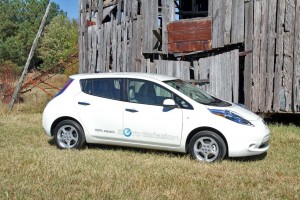Nissan may be forced to delay production of its Leaf battery car at its main U.S. assembly plant in Smyrna, Tennessee, company officials are warning, due to ongoing problems resulting from Japan’s March 11 natural disaster.
The earthquake and tsunami disaster that hit Japan has already had a significant impact on the roll out of the Nissan Leaf battery cars, delaying the planned spring ramp-up of production at the launch plant in Japan. Nonetheless, the March 11 disaster also is helping demonstrate that EVs can fit into modern society without a lot of fuss, the maker claims.
The March earthquake and tsunami is likely to cost Japanese automakers more than a million units of lost production, while severely reducing profits for the year. (Honda projecting a two-thirds drop in profits for the fiscal year. Click Here for more.) Significantly, some key launches are being impacted, including significant delays in the ramp-up of the 2012 Honda Civic and a several-month delay in the introduction of the new Toyota Prius V.
It has taken Nissan, meanwhile, longer to build up production of the Leaf, while Hideaki Watanabe, Nissan vice president for zero emission vehicles, said the timing of the planned opening of the Leaf assembly line in Smyrna is uncertain.
“After March 11, all the resources of the company were devoted to helping with the recovery (in Japan.) This delayed the planning,” he said. “It put us in a very difficult situation,” Watanabe told a group of reporters.
“We’re trying to shorten the delay but I wouldn’t want to make any predictions,” Watanabe said.
Through the end of May, Nissan has delivered 7,550 electric-powered Leafs to customers around the world. That included almost 5,000 Leafs delivered to customers in Japan, more than 66 of them used in three prefectures heavily damaged in the quake and tsunami.
The EVs proved to be more practical than gasoline vehicles, Watanabe claimed, because they could plug in and recharge in areas where motor fuel was in short supply. Nissan is also now exploring technology that would turn the Leaf and its lithium-ion battery into an emergency generator, said Watanabe.
The Leaf EVs also survived the electricity shortages because the experience of most owners is to drive less than 60 miles per day and then recharge at night when electricity is available, Watanabe said.
About 2,000 Leafs have been delivered to customers in the U.S. and the company still has the names of 22,000 more potential numbers. Filling order has been slower than expected because Nissan won’t be able to meet its 2011 production target of 50,000 Leafs.
“In 2012, we hope to be in a more normal situation,” he said.
However, Nissan plans to begin distributing the Leaf beyond the original seven states targeted in the initial launch of the vehicle, which included California, Oregon, Washington, Arizona, Texas and Tennessee. Leafs will be in dealers in a half dozen states along the U.S. Atlantic Seaboard from Florida to Maryland this fall and in all 50 states by the end of 2012, Nissan officials said.
“Even before the earthquake, we decided on a very conservative ramp up. We wanted to double check everything. Quality is our top priority,” he said, adding most of the complaints from American customers have involved a lack of timely information.

